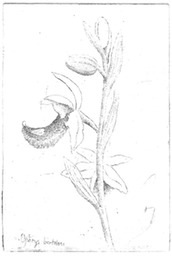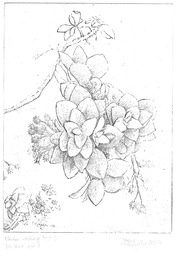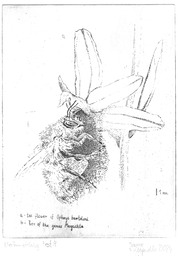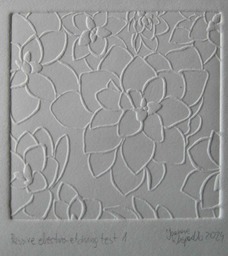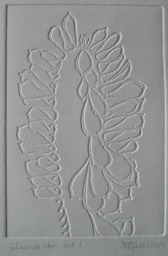
We recently hosted Joanna Klepadlo (Poland, 1990) for one of our to-week electro-etching workshop-residencies. An artist, and a nature illustrator, specialising in Mediterranean flora, she currently lives on the Ligurian coast of Italy. She holds a degree in Fine Arts from the Nicolaus Copernicus University in Toruń (Poland) and has a master’s degree in printmaking.
Joanna is an exceptional artist. When I received her email in November 2023, showing her interest in electro-etching due to its safety for both the artist and the environment, I was deeply impressed by her delicate drawings of plants, stems, flowers, and seeds. I promptly invited her to our workshop, convinced that it would be a privilege for her to be trained in the technique of electro-etching, and for me to show it to her.
During her stay, Joanna began working on electrolytic etching, carefully following each step necessary to set up her own e-e unit. She experimented with different types of tanks: vertical, flat, and even a special one for etching through electrolysis without electricity.
Her nature drawings are so precise that they require great concentration and take a lot of time. She uses delicate lines and tiny dots, created with a very fine needle. Adapting the electrolytic etching process to her technique has been quite a challenge. The pieces she produced were tests aimed at achieving greater fluidity and precision in transferring her drawings onto the different varnishes we use, such as Charbonnel ultraflex, graphite ink, and BIG (Baldwin Intaglio Ground).
Pictures from the workshop
Joanna Klepadlo speaks about her experience in the workshop-residency
Jestem ilustratorką przyrody i obecnie ilustruję gatunki zagrożone w regionie Morza Śródziemnego. Mimo, że skończyłam studia o specjalności grafika warsztatowa, później pracowałam w innych technikach ze względu na toksyczność konwencjonalnych technik nauczanych na uniwersytecie. Podczas kursu trawienia elektrolitycznego Alfonso Crujery moim celem było zdobycie umiejętności, których potrzebuję, aby w mniej toksyczny sposób przywrócić grafikę do mojej praktyki artystycznej. Chciałam także zbadać inne aspekty zrównoważonego rozwoju związane z prowadzeniem pracowni graficznej oraz poznać lokalną różnorodność biologiczną, zwłaszcza rodzime rośliny.
Podczas intensywnych dwóch tygodni dowiedziałam się, jak działa elektroliza i zapoznałam się z różnymi możliwościami, jakie ona oferuje. Alfonso z wielką cierpliwością i entuzjazmem wyjaśnił proces trawienia elektrolitycznego. Ze względu na charakter mojej pracy (rysuję bardzo powoli, z dużą dbałością o szczegóły), podczas rezydencji nie starczyłoby mi czasu na tworzenie dopracowanych grafik, więc moim celem było wykonanie szkiców mniej więcej przypominających to, co zwykle robię, aby zobaczyć, czy uda mi się osiągnąć określone efekty poprzez trawienie elektrolityczne. Choć nie udało mi się przed zakończeniem warsztatów dopasować trawienia elektrolitycznego do swojego stylu rysowania (bardzo cienkie linie i punktowanie), to teraz jestem wyposażona w wiedzę, która pozwoli mi dalej eksperymentować samodzielnie.
Warsztaty były cenną okazją do poznania aspektów ekologicznych w prowadzeniu pracowni graficznej. Wypróbowałam różne mniej toksyczne werniksy i rozpuszczalniki, i zrozumiałam jak działa utylizacja odpadów podczas pracy z siarczanem miedzi. Alfonso chętnie dzielił się wiedzą i wyjaśniał każdy szczegół, o który pytałam. Zanotowałam wszystkie szczegóły dotyczące organizacji pracowni, aby w przyszłości móc zorganizować własną.
Jako ilustratorka przyrody zainteresowana głównie roślinami, chciałam jak najlepiej wykorzystać swój czas na Gran Canarii poznając lokalną florę. Mimo, że praca w studiu zajęła mi więcej czasu niż się spodziewałam, udało mi się znaleźć trochę czasu na poznanie rodzimych roślin kanaryjskich. Alfonso i jego żona Amparo przekazali mi mnóstwo informacji i pomogli dotrzeć do miejsc o szczególnym znaczeniu botanicznym. Jestem za to naprawdę wdzięczna i miło było znaleźć się wśród ludzi, którzy cenią botanikę!
Dwa tygodnie warsztatów były pełne intensywnej nauki, prób, błędów i odkrywania. Przez cały mój pobyt czułam się jak w domu dzięki wyjątkowej gościnności i opiece Alfonso i Amparo.
Mój pobyt na rezydencji był możliwy dzięki grantowi mobilnościowemu Culture Moves Europe finansowanemu z programu Unii Europejskiej Kreatywna Europa i realizowanemu przez Goethe-Institut. (https://www.goethe.de/en/kul/foe/cmm.html)
------------------------------------ English translation by Joanna Klepadlo --------------------------------------
I am a naturalist illustrator, currently illustrating endangered species in the Mediterranean region. Despite originally specializing in printmaking, I have subsequently worked using different techniques because of the toxicity of the conventional techniques that I was taught at university. In Alfonso Crujera’s electro-etching workshop, my goals were to learn skills that I need in order to bring printmaking back into my artistic practice in a less-toxic way. I also wanted to explore other sustainability aspects of running a printmaking workshop, and to explore local biodiversity, especially native plants.
During the intensive two weeks I learnt how electrolysis works and I explored various possibilities it offers. Alfonso explained the process of electroetching with great patience and enthusiasm. Because of the nature of my work (I draw very slowly with a lot of attention to detail), during the residency I wouldn't have had enough time to create artworks, so my aim was to make sketches that roughly resembled what I usually do, just to see if I could achieve certain effects through electroetching. Although I didn't manage to adjust electro-etching to my style of drawing (very fine lines and stippling) before the end of the workshop, I am now equipped with knowledge that I need to experiment further on my own.
The workshop was a valuable chance to explore sustainability aspects of running a printmaking studio. I tried various less-toxic varnishes and solvents and I understood how waste disposal works when working with copper sulphate. Alfonso was very generous with his knowledge and he explained every detail I asked about. I took notes of all the nitty-gritty of the organisation of the studio, so that in the future I can set up my own printmaking workshop.
As a naturalist illustrator mostly interested in plants, I wanted to make the most of my time in Gran Canaria by exploring local flora. Even though the work in the studio took more time than I had expected, I still found some time to get to know some native Canarian plants. Alfonso and his wife Amparo provided me with plenty of information and helped me to get to the places of particular botanical interest. I am really grateful for that, and it felt so good to be among people who appreciate botany!
The two weeks of the workshop were full of intensive learning, trials, errors and exploring. Throughout my stay I felt at home thanks to the outstanding hospitality and care of Alfonso and Amparo.
My stay at the residency was possible thanks to the Culture Moves Europe mobility grant funded by the Creative Europe programme of the European Union and implemented by Goethe-Institut. (https://www.goethe.de/en/kul/foe/cmm.html)
Joanna Klepadlo's electro-etchings
